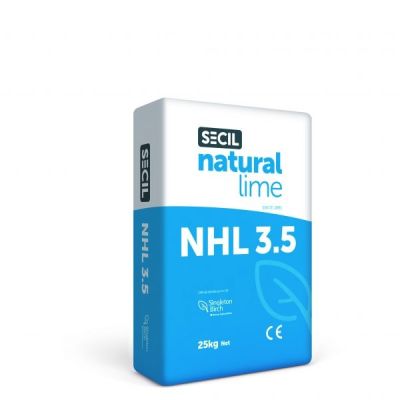Components - Types of Lime
Bethany Evans Posted this on 08 Apr 2024
There are many types of building lime on the market. It is crucially important to understand their differences and the way in which they perform, only then is it possible to make an informed choice about which lime to use for different applications and environments.
Slaked/High Calcium/Putty/Air/‘Fat’ or Non-Hydraulic Lime
This lime is produced by slaking fresh Quicklime in an excess of water. It is also known as non-hydraulic lime because it requires exposure to air in order to carbonate and does not set under water.
This lime is regarded as the most appropriate lime for old buildings or ‘softer’ substrates where maximum permeability, capillarity and flexibility is required.
Premixed ‘wet’ products are made from lime putty with the addition of an aggregate (or alternative) and/or fibre.
Hydrated or ‘bag’ lime
This is the lime generally available in agricultural and builders merchants. It is a non-hydraulic lime produced by slaking Quicklime with a shortfall of water which results in a powder. It is generally considered to be an inferior product to the fat lime putty described above for a number of reasons but primarily because it starts to degrade from the moment it is made and can actually fully carbonate in the bag before use. Widespread use of ‘bag’ lime has given ‘lime’ a poor name because of the instances where it simply has none of its original properties left by the time the end-user works with it, hence it fails, dusts etc. If ‘bag’ lime is the only option, then it should be purchased as fresh as possible and left to soak for two days in clean water. Although the resulting product is chemically the same as ‘fat’ lime putty, it is physically different, in particular, it is less ‘sticky’. A cement mix with a shovel of hydrated/bag lime in it is not a lime mortar, in this instance, the lime is simply being used as a plasticiser. It should not be used in pre-1919 buildings!
Natural Hydraulic Lime (NHL)
This ‘hydrated’ lime is different to the ‘bag’ lime as it is produced from limestone naturally containing clay and other impurities which enable it to set without exposure to air; it is therefore used for providing a faster initial set in more extreme conditions including under water. There are many types of hydraulic lime and they are categorised according to the following (NHL - Naturally Hydraulic Lime):
- Feebly hydraulic lime (NHL 2) – contains less than 12% clay which means it is slower to set (about 20 days in water);
- Moderately hydraulic lime (NHL3.5) – contains 12%-18% clay which gives a slightly faster set (15-20 days in water);
- Eminently hydraulic lime (NHL5) – has up to 25% clay content which means that a much faster set is achieved (hours/days).
These limes have become increasingly popular over the last decade because of their comparative ‘ease of use’ and ‘strength’, compared to fat lime products, but see Choosing Lime for ‘trade-off’ chart. It is important to understand the building, Its location and construction materials to provide an informed specification for which lime to choose.
Hydraulic Lime (HL)
These contain lime and other materials such as cement, blast-furnace slag, fly ash and limestone filler. Manufacturers are not required to state the composition of hydraulic lime.
Formulated Lime (FL)
These contain lime with hydraulic properties comprising air lime and/or NHL with added hydraulic and/or pozzolanic material – classified according to its compressive strength.
Natural/Roman cement
Natural or ‘Roman’ cement was extensively used in the 19th century (nothing to do with the Romans). It is based on a naturally occurring limestone containing clay and unlike the fat lime products above, was not slaked, just ground. This product comes from a single, naturally occurring mineral, unlike Portland cement which consists of ingredients blended together. It was appreciated for four main reasons: fast set, strength, aesthetics and durability. It was patented in 1796 and used for run moulding, precast moulds, artificial stone, stonework joints (especially canals), floors (terrazzo) and fresh plaster sculpting. It is still available today, ‘Prompt’ is an example.
Pozzolans
Pozzolans are ‘heated’ materials such as brickdust, GGBFS (Granulated Ground Blast Furnace Slag), Pulverised Fuel Ash (PFA), Calcined Clay; that contain silica, alumina and iron which become reactive towards alkalis including lime. They help to give a fat lime mortar a ‘faster’ set (essentially creating an ‘artificial’ hydraulic lime) and are therefore helpful in many situations to broaden the applications for fat limes. It is believed that many historic mortars were ‘fat’ or ‘non-hydraulic’ as those that have been analysed contained these ‘heated material’ which changed the performance of the mortar.




